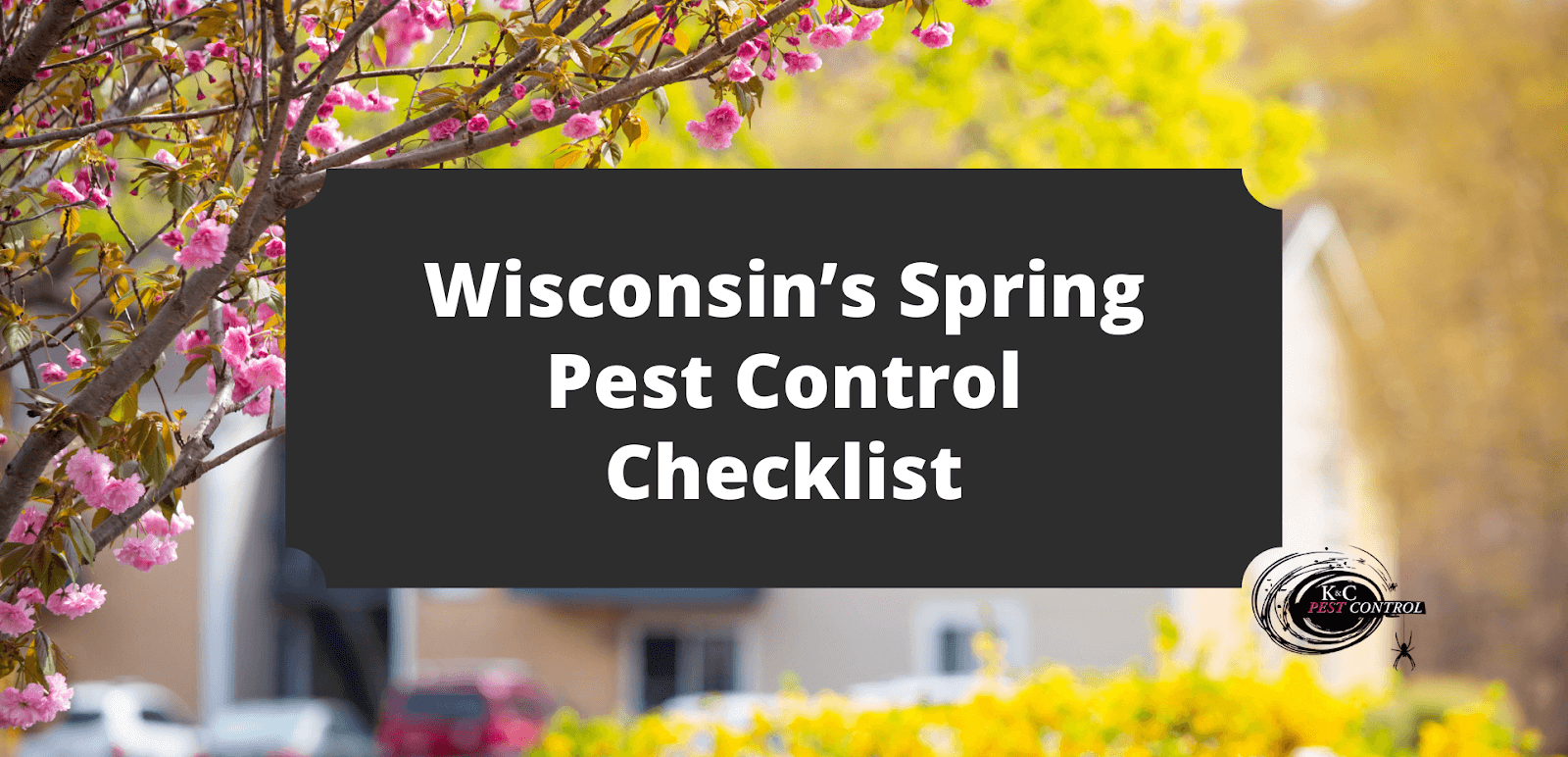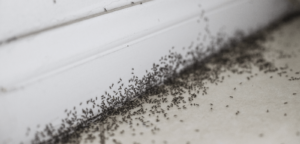Wisconsin’s Spring Pest Control Checklist

With the spring season quickly approaching in Wisconsin, maintaining a pest-free home and business is important in keeping your family and employees safe.
The professionals at K&C Pest Control have compiled a list of the top ways to prevent pests this spring. Use this spring pest control checklist to prevent a pest infestation in your home or business.
Preparing Your Home for Spring Pests
Prevent pests in your home with the following Wisconsin pest control steps:
Exterior Maintenance
- Inspect and repair cracks and crevices.
- Inspecting your home or business for cracks and crevices is crucial in preventing pests from getting into your home.
- Use a flashlight to thoroughly examine exterior walls, the foundation of your home, and windows for any openings.
- Seal cracks or gaps with weatherproof caulk or foam insulation to keep pests out.
- Clean gutters and downspouts.
- Cleaning gutters and downspouts are essential for preventing water buildup, which can attract pests like mosquitoes, paper wasps, and rodents.
- Remove debris such as leaves and twigs regularly to maintain proper drainage and reduce the risk of pest infestations around your home or business.
- Trim vegetation away from your home.
- Trimming vegetation can help eliminate hiding spots and pathways for common spring pests like ants, mice, and squirrels.
- Maintain a clearance of at least 2 feet around your home’s foundation to reduce the risk of pests gaining access to your property.
Interior Preparations

- Seal entry points.
- Sealing entry points around doors, windows, and utility penetrations is vital for keeping pests out of your home or business.
- Use weatherstripping, door sweeps, and silicone caulk to seal any cracks or openings where pests could enter.
- Regularly inspect and repair damaged seals to maintain a pest-resistant barrier and safeguard your home.
- Store food properly.
- Properly sealing food helps prevent pests like ants and mice from contaminating your pantry.
- Store food — especially dry goods such as grains, cereals, and pet food — in tightly sealed plastic or glass containers to deter pests and maintain freshness.
- Regularly check for any signs of pest activity in your pantry and promptly dispose of any infested items that weren’t securely sealed.
- Regularly clean your home.
- Regularly cleaning your home removes food crumbs, spills, and other debris that can attract pests like ants, cockroaches, and rodents.
- Vacuuming carpets, sweeping floors, and wiping down countertops daily help eliminate sources of food and shelter for pests, reducing the risk of infestations.
- Declutter your living space.
- Decluttering and proper waste disposal also help maintain a pest-free environment in your home. Close garbage cans, take the trash out frequently and wipe down countertops of any spills or crumbs.
- When your space is clear, you can notice signs of pests quickly, helping you avoid the risk of a large infestation.
Pest-Resistant Landscaping
- Choose and properly place pest-resistant plants.
- When selecting plants for your landscaping, opt for varieties known to be pest-resistant, such as lavender, marigolds, and rosemary.
- Proper placement of pest-resistant plants around your home can act as a natural barrier, deterring pests like mosquitoes and aphids.
- Avoid planting susceptible species near entry points and windows to minimize the risk of pests infiltrating your home or business.
- Mulch and weed control.
- Applying a layer of mulch around your landscaping helps retain moisture, suppresses weeds, and discourages pests by reducing potential hiding spots.
- Choose mulch options like cedar or pine bark with natural pest-repelling properties to deter unwanted insects further.
- Regularly removing weeds from your garden beds and maintaining a weed-free landscape minimizes available food sources and nesting areas for pests, contributing to a healthier outdoor environment.
- Establish water management practices.
- Implementing proper water management practices, such as fixing leaks and ensuring proper drainage, helps reduce excess moisture that attracts pests like mosquitoes and termites.
- Regularly inspect and repair leaky faucets, hoses, or irrigation systems to prevent standing water accumulation, which serves as a breeding ground for pests.
- Ensure that gutters and downspouts direct water away from your home’s foundation to minimize moisture buildup and decrease the likelihood of pest infestations.
Pest Prevention Strategies for Businesses
Keep your employees, customers, and clients safe with these spring pest control tips for your business.
Sanitation Practices
- Properly dispose of waste.
- Since businesses see a lot of use and foot traffic, proper waste disposal is crucial for minimizing pest attraction and infestation risks.
- Use securely sealed trash cans with tight-fitting lids to prevent pests like flies, rodents, squirrels, and raccoons from accessing food waste.
- Regularly empty and clean trash receptacles to remove odors and debris that can lure pests, maintaining a clean and pest-free environment.
- Stick to regular cleaning schedules.
- A regular cleaning schedule ensures that all areas of your home or business are consistently maintained, reducing the risk of pest infestations.
- Designate specific tasks for daily, weekly, and monthly cleaning routines to address potential pest attractants such as spills, crumbs, and clutter, promoting a hygienic environment.
Building Maintenance

- Seal entry points and gaps.
- Sealing entry points at your business, such as gaps around doors, windows, and utility penetrations, is crucial for preventing pests from infiltrating your premises.
- Utilize weatherstripping, door sweeps, and silicone caulking to seal any openings that pests could use to access your business, ensuring a pest-free environment for employees and customers.
- Ensure all doors and windows are closed.
- Monitor for signs of pest activity.
- Regularly monitoring for signs of pest activity, such as droppings, gnaw marks, or unusual odors, allows businesses to detect pest problems early and take swift action.
- Implementing a continuous pest monitoring program, including inspections of key areas like storage rooms, break rooms, and kitchens, helps businesses identify and address pest issues before they escalate, safeguarding against potential damage and health risks.
Professional Pest Management
- Partner with pest control professionals.
- Partnering with pest control professionals ensures businesses have access to expert knowledge, effective treatments, and ongoing monitoring to prevent and manage pest infestations.
- Collaborating with pest control professionals provides peace of mind, allowing businesses to focus on their operations while knowing that comprehensive pest management measures are in place to protect their premises and reputation.
- Regular inspections and customized treatment plans.
- Regular inspections conducted by pest control professionals allow for the early detection of pest issues and the development of customized treatment plans tailored to the specific needs of each business, whether it’s an office space, restaurant, or manufacturing facility.
- By assessing factors such as the type of pests present, the layout of the facility, and any unique vulnerabilities, pest control professionals can implement targeted interventions to manage pest populations effectively.
- Ongoing monitoring and adjustment of treatment plans ensure that businesses maintain a pest-free environment over time, promoting the health and safety of employees and customers alike.
Spring Pest Alert: Signs to Look Out For

In the spring, several signs indicate a potential pest infestation in your home or business:
- Increased Pest Activity: Sightings of pests indoors or outdoors, such as ants, flies, cockroaches, or rodents, may indicate an infestation.
- Droppings: Finding droppings or feces in areas like kitchen cabinets, pantry shelves, or along baseboards can signal the presence of rodents or insects.
- Gnaw Marks: Chewed wires, furniture, or food packaging suggest the presence of rodents or other gnawing pests.
- Nesting Materials: Discovering nests, webbing, or shredded paper in secluded areas indicates the presence of pests like rodents or insects.
- Strange Odors: Foul or musty odors, particularly in enclosed spaces like attics, storage areas, or crawl spaces, may indicate the presence of pests or their nesting materials.
- Damage to Plants: Wilting, yellowing, or chewed foliage in the garden suggests the presence of pests like aphids, caterpillars, or rodents.
- Holes and Entry Points: Finding holes, cracks, or gaps in walls, floors, or foundation areas where pests could enter the building.
- Noises: Hearing scratching, scurrying, or rustling sounds within walls, ceilings, or attics may indicate the presence of rodents or insects.
- Visible Damage: Damage to food packages, stored items, or structural components like wood beams or insulation may indicate pest activity.
- Pest Droppings: Finding droppings or fecal matter around the premises, especially near food sources or nesting areas, clearly indicates pest presence.
Integrated Pest Management With K&C Pest Control
Looking for a spring pest control specialist in the Fox Cities area? Our experts can assist with current infestations or preventative measures to keep your residential or commercial property pest-free. If you live in Oshkosh, Appleton, Neenah, Menasha, or the surrounding areas, contact us for an inspection, evaluation, and ongoing protection to experience the peace of mind that comes with a protected home or business.
